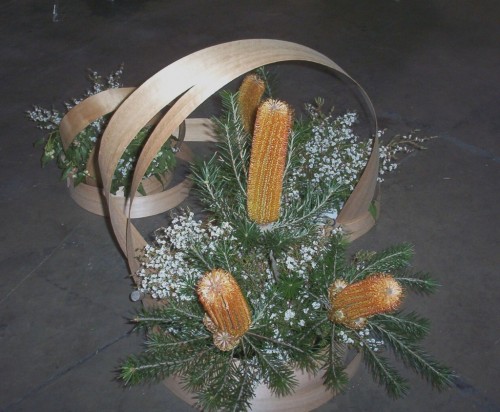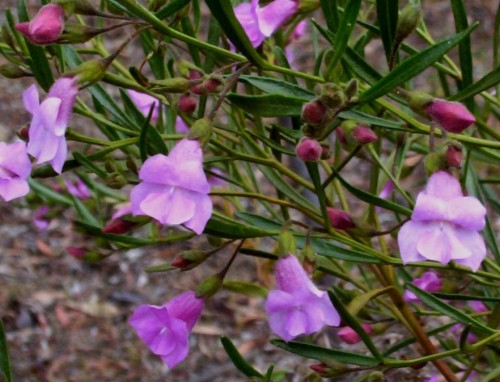Flower Arrangements With Australian Native Plants
At the Plant Sale and Flower Show today I took some photos of flower arrangements done in a form of Ikebana style. The very bold and brash Banksias and Waratahs featured in them all. The members of this particular flower arranging group have made floral arrangements for the last few Flower Shows. They certainly showcase these exciting flowers.
The photo above features Banksia spinulosa and Thryptomene. The Pavilion where this display was housed had all sorts of distracting features on the walls and around the cut flowers. It was quite tricky getting a photo which did not have too much in the background.
Eremophila complanata
Eremophila complanata is another of those tough lime and drought tolerant plants. It is in full flower at the moment making a lovely splash of colour.
Before using Australian Natives as cut flowers became more widely practised, we knew that this one kept for two weeks in a vase. It is still not on any published lists of plants suitable for the cut flower trade.
When our local group of the Australian Plant Society used to organise a Spring Flower Show we got to know how many species behaved when cut for display.
Eremophila complanata is a shrub to about one and a half metres, by nearly a metre wide. It would be a bit smaller if I took cuts from the bush regularly. It becomes straggly if not trimmed after flowering.
Everlasting Daisy Seeds
I found this article on the ABC Web site. Rain is needed to germinate these lovely plants or a sprinkler if allowed. Many areas in Australia are in drought and extra water for sprinkling is not available.
Everlastings lasting all year round.
Thursday, 24 August 2006
Presenter: Sian Gard
The Midwest and wheatbelt is famous around Australia for the wildflower season. Carpets of colourful flowers usually cover the ground from August to October, but not this year. The drought has considerably reduced the number of wildflowers.
What if you could have wildflowers in your very own garden, all year round?
Rob and Jen Warburton of Kojonup have turned the idea of growing wildflowers where you live into a growing business of selling everlasting seeds. Rob says the business came about, almost by accident ” We had a fellow collecting native seeds on our property on 200 hundred acres of bush we’ve got and just as a bi-product he sort of said, heres a kilo of seed why don’t you see if you can grow these things commercially, there’s a bit of a market for it”
Do these beautiful flowers need much care and attention when it comes to popping them in the garden? Not according to Rob ” we get the seeds and throw them on the ground, like you should do, like it happens in nature”
But with the size of the seeds and the amount of flowers that could spring up, you would think that making the everlasting seeds profitable and viable would be a labour intensive chore.
” Eventually the everlastings came up and we thought how are we going to harvest them? Says Rob ” I sort of then worked out a way for mechanically harvesting them, so by the time I had harvested them and put them through several process of cleaning them, we came out with quite a clean product. We were able to sell that and that was about five years ago”
There are hundreds or maybe even thousands of different types of flowers in the world to plant in your garden, but according to Rob what makes the everlasting or paper daises stand out is its uniqueness.
” There a long flowering annual, they come in lots of different colours. We grow the pink and white variety and also the pink variety, which is a very dark red sort of pink colour with a yellow centre, and some of them have a black centre, which is quite stunning as well. They grow through the winter months and flower mostly through the spring ” but as Rob explains these flowers can bring delight all year round “they can be grown all year, we have grown them in patches in November and they have flowered throughout the summer”
The pretty but very simple everlasting is not only a flower that is found in the Midwest and wheatbelt and admired by tourists, it’s a flower, which according to Rob is gaining popularity in the celebration of an everlasting union, marriage.
” We’ve had people who have picked the flowers and dried them, they’ve used them as table displays, in the bouquets themselves and we know a girl just locally who is very keen, who’s having a wedding in December, to come out and pick some flowers and dry them for table arrangements”
Australian Natives at the Chelsea Flower Show
Australians again won a gold medal at the Chelsea Flower Show for an Australian Show Garden. The design reflects the Australian outdoors lifestyle, with outdoor living areas and a great built-in barbecue and outdoor kitchen. I would love to have even a very modified version of this!
There is a list of the plants used on the website. I was a bit disappointed really. There were only 6 Native Australian plants, that I recognised.
- Dianella revoluta ‘Baby Bliss’
- Dianella revoluta ‘Little Rev’
- Dianella tasmanica ‘DT23’ (PBR) Emerald Arch
- Dianella caerulea ‘DCNCO’ (PBR) Breeze
- Thysanotus multiflorus
- Xanthorrhoea priessii
The idea was to use hardy, drought resistant plants. I can think of a number of others that would fit this category, that are Australian native plants. However the plants in this list are special in their features.
Tasmannia lanceolata (Mountain Pepper Bush)
This is a rounded shrub to 2 metres high by 2 metres wide. It has dark green, shiny elliptical (like an ellipse) leaves to 7 cm long and cream flowers in summer. The fruits (berries) are almost black and the stems red. It sounds a most attractive plant to grow. As it is alpine, it would probably do best in a pot here, although Tasmannia species are adaptable according to my reasearch. A shade house would be a good place to try one of these plants.
The plants are frost hardy and prefer a well composted soil and half to full shade. Definitely won’t cope with the high pH soil in the garden. Sounds like a pot specimen to me. They are usually grown from cuttings, but it is worth trying seed.
All parts of the plant have a hot flavour. I think the leaves are quite mild, but the flavour is very good. I still haven’t tried the dried berries yet but they are bound to be much hotter in flavour.



